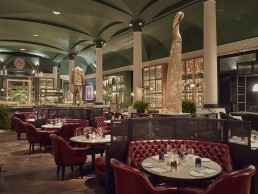
Kerridge’s Bar & Grill, UK
Beginning his ventures with a Michelin Star rated traditional British pub in Marlow, Tom Kerridge has earned the respect of the hospitality industry through the opening of his fourth culinary space in the heart of capital at the Corinthia Hotel London.
Originally the site for the Massimo Restaurant and Grill designed by David Collins Studio, the Studio’s team returned seven years later to give the grand space a face lift for the new Kerridge’s Bar & Grill.
Along with David Collins Studio, dpa lighting consultants were brought in to complete the lighting design. Having previously worked with Corinthia Hotel London on different projects, the team were asked back to create a design that met the needs of the hotel’s overall aesthetic, budget, timeframe and ease of use.
The original design for the Massimo Restaurant and Grill was pastel toned with a central line of giant glass bauble chandeliers in the centre of the vast room. Kerridge had a clear vision to create a much more personal, intimate and romantic environment for his diners. Aware that the weight of bearing a Michelin status can put some potential customers off from visiting, Kerridge felt it was key to draw inspiration from his pub in Marlow that welcomes all into it’s comfortable dining experience.
Upon entering the Corinthia Hotel London restaurant, customers are welcomed by large barrels of real ale that present a sense of familiarity through scent and sight that immediately sets the tone for the dining space.
Simon Rawlings of David Collins Studio described their aim to “de-emphasise the structure of the room by pairing back columns, painting the ceiling very dark and creating an engulfing layout so you feel cosy everywhere you sit in the space.”
Taking historical inspiration from the Victorian aesthetics, the interior design team decided to paint the vaulted ceiling a deep green, which draws the high ceilings down to a more comfortable human level. It is also in keeping with the architecture of the Corinthia Hotel London, which is believed to be from the Victorian era.
In order to gather the vision Kerridge was proposing to the design teams, Rawlingss visited the Hand and Flower pub in Marlow to get a sense of the interior and lighting design in situ. Creating a similar mood evoking “heart and soul” was very important to Kerridge in the new location, as well as making a strong link with food and its preparation.
Rawlings explained: “The brief was to create a very welcoming space; a room that reflected Tom’s personality and food, with a nod to the Hand and Flowers in Marlow. The restaurant needed touches of nostalgia but still needed to reflect the building’s grandeur, and feel very British.”
Throughout the cosy and rich interior, chunky dark furniture compliments the dark green ceiling, creating an intimate dining experience. Sunken wine fridges are spot lit alongside open rotisseries and red meats hang in contained display cabinets.
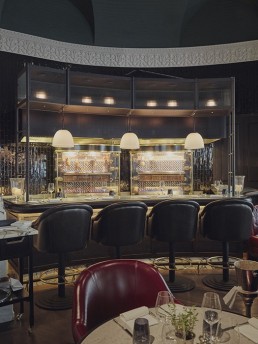
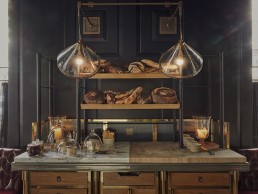
Alongside, pieces of artwork that are personal to Kerridge are illuminated as points of interest, including the work of Kerridge’s wife, Beth Cullen Kerridge.
Shayne Grist of dpa lighting consultants explained to darc their involvement at the beginning of the project: “We needed to liaise closely with David Collins Studio to ensure that we were complimenting the vision they had, which was developed with Kerridge and his team. The key aim for the refurbishment was to bring the scale of the space down to a more human level; with a ceiling height of almost eight metres, the intention was to create a more personal dining experience and the lighting design therefore needed to support this concept.
“Our design work started at the end of April, the existing restaurant closed on 9th June and the new restaurant officially opened on 10th September, so an exceptionally short timeframe,”
“The changes to the decorative lighting from the existing restaurant to the new played a very important role in achieving the concept of bringing the scale down to a lower level,” explained Grist.
“The previous lighting scheme included four oversized globe chandeliers, which helped express the large volume above the dining and bar area. These were removed in the new design and replaced with ceiling apertures for discreet narrow beam spotlighting. Several existing decorative luminaires were retained in the new scheme, which utilise tungsten filament lamps producing a very romantic warm light.” Retaining this warmth in the lighting was felt very important to both David Collins Studio and lighting consultants dpa, in creating the intimate atmosphere.
“New gantry style structures were introduced at the bar counter and also for the new rotisserie counter, which were both functional and decorative,” continues Grist.
“Both structures feature globe tungsten filament lamps hanging behind reeded glass. At the bar, miniature recessed downlights in the underside of the structure illuminate hanging glasses, which create a sparkle as though they are purely intended to be lit. New floor lamps located on plinths and table lamps to booth seating were introduced into the dining and bar areas to further enhance the atmosphere at low level.”
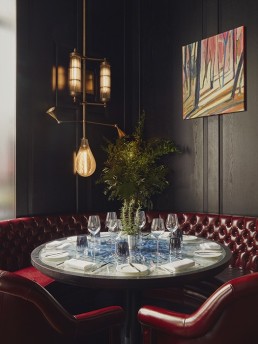
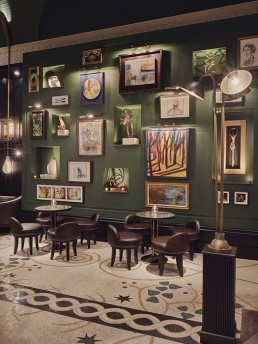
Each area of the restaurant space was carefully identified and allocated a specific lighting fixture to suit its needs. Ceiling spots were integrated into large openings to allow each table to be individually lit, ensuring the food and service look good at all times. The architectural spotlighting was provided with narrow beam lamps and existing spotlights were re-lamped to narrow beams to allow for easing focus on dining, artwork and counter tops at low levels. Tungsten halogen lamp picture lights illuminate artworks in the bar area and sculptures in niches have miniature LED warm white spot uplights.
“I created a colonnade of torches through the room, which really, I believe, give the overall lighting scheme grounding, and add a very unique aesthetic to the room,” adds Rawlings.
Working within an old building did bring some architectural constraints for the project, as you would expect. A structural engineer was brought in to advise the design team with issues such as providing power from the lower level to the new floor lamps. This complicated process required the installation of new cabling to be placed in advised locations avoiding structural columns. Grist explained the installation of the new ceiling fixtures: “It was not possible to confirm if the new ceiling apertures, introduced in place of existing chandeliers, could be realised until the chandeliers were removed. Once this had happened, we discovered that there was an existing structure holding the vaulted ceiling in place, which clashed with our proposed depth requirements to ensure the spotlights were concealed. We were able to work with the contractor to create the necessary space around the structure, keeping these luminaries as discreet as possible.”
Each component is separately controlled and dimmed to create the ideal visual balance throughout the restaurant during both day and night. “As with many of our projects candles are as important, if not more important, that all the other lighting elements providing that soft dancing light across the tables and brushing people’s faces with a warm glow. The whole space has a beautiful softness and warmth both during the day and at night,” commented Nick Hoggett, dpa lighting consultants partner.
The overall British style that heavily influenced the Marlow pub was successfully carried through to Kerridge’s new location and was vamped into a sophisticated dining experience in this central London Hotel. The rich colours, fabric textures and lighting all reflect the decadent yet hearty food Kerridge’s team serve up.
“The success of the lighting is a direct result of the rich colour palette of the interiors, vibrant new art and dramatic sculptural pieces,” regarded Grist.



